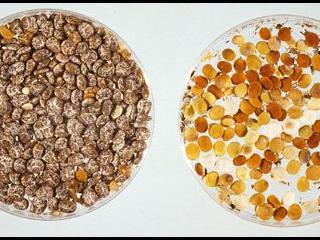Phomopsis stem and pod blight
Phomopsis stem and pod blight (Diaporthe toxica) occasionally causes yield losses, however the major impact of infection is the production of a mycotoxin (phomopsin) by the fungus as it grows in mature lupin stems or in seed. The toxin can cause sickness or death (lupinosis) in livestock if grazing of infected stubble is poorly managed. Spores released in winter from fruiting bodies on stubble infect growing lupin plants but rarely cause lesions at this stage unless plants are stressed by drought, herbicide or frost. The infection remains latent as microscopic structures until senescence of the plant tissue. Moisture, such as summer rain, on the mature infected tissue allows the fungus to grow saprophytically producing the mycotoxin and also new fruiting bodies.
Symptoms
Symptoms usually appear on senescing or dry lupin stems as dark purplish brown lesions which bleach with age and contain black fruiting bodies. Lesions can develop on pods, causing the surface of green pods to become ‘slimy’ and mature pods to be shrivelled with dark discolouration. Pod lesions can lead to seed infection, causing shrivelled seed or whole seeds with golden brown discolouration. Infected seed may also contain mycotoxin.
Management
- Variety resistance is the most effective way of reducing phomopsis.
- All current narrow leafed lupin varieties have moderate levels of resistance to stem and pod infection, although stem and pod resistance can be independent and may difffer within individual varieties.
- If weather conditions favour the pathogen (prolonged rainfall or high humidity in late spring and summer), stubble may still develop some toxicity requiring care with grazing, however usually current varieties do not produce highly toxic stubbles.
- Increasing breaks between lupin crops allows weathering and breakdown of infected stubble, reducing disease inoculum.

